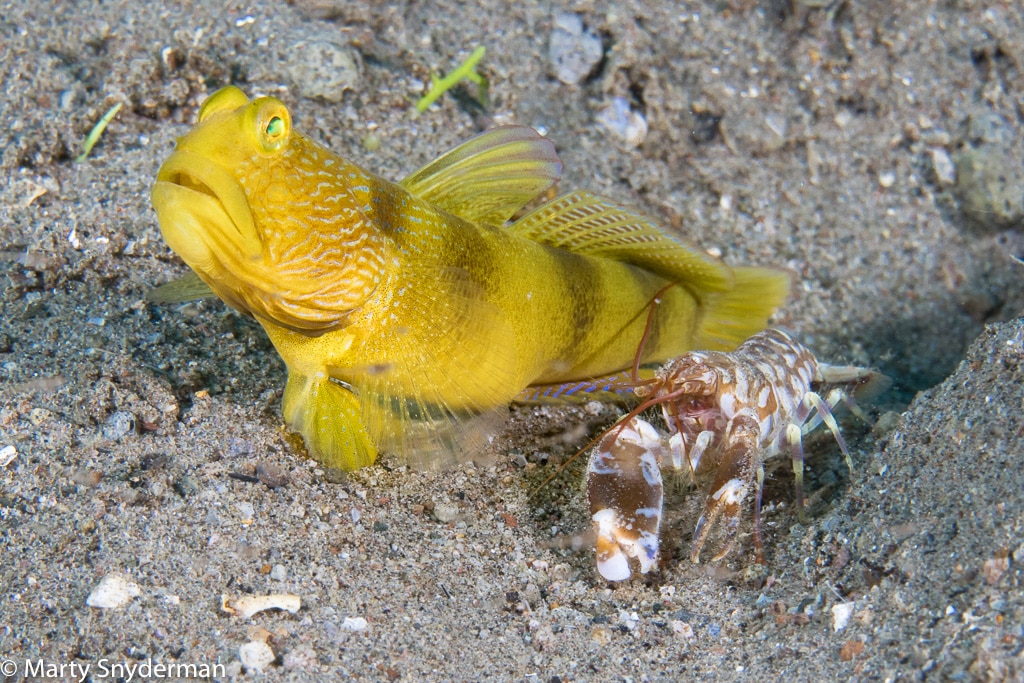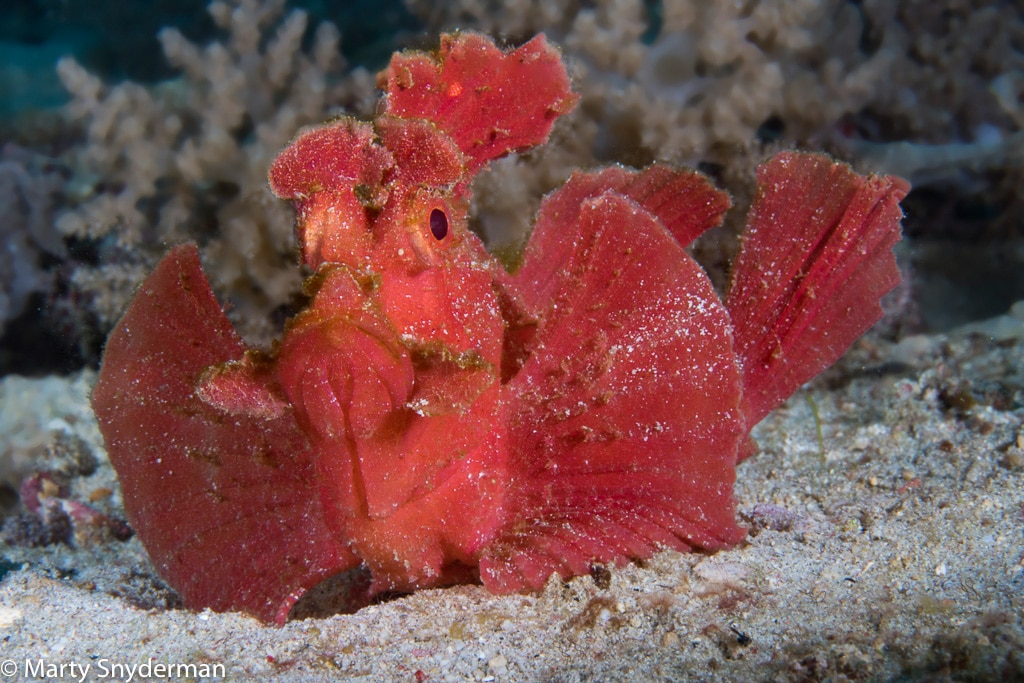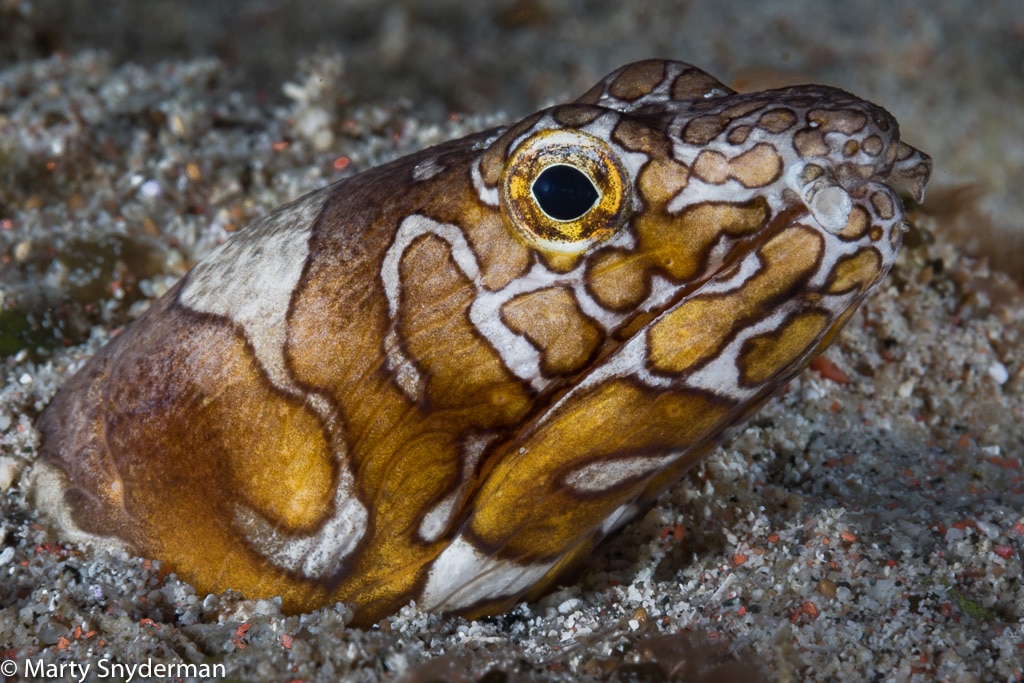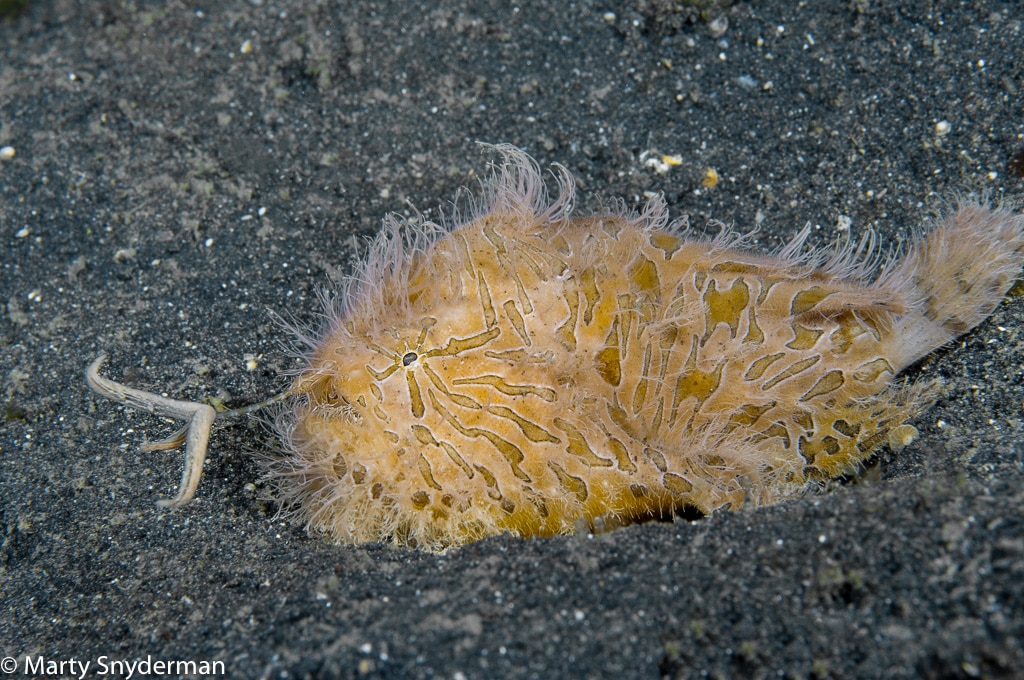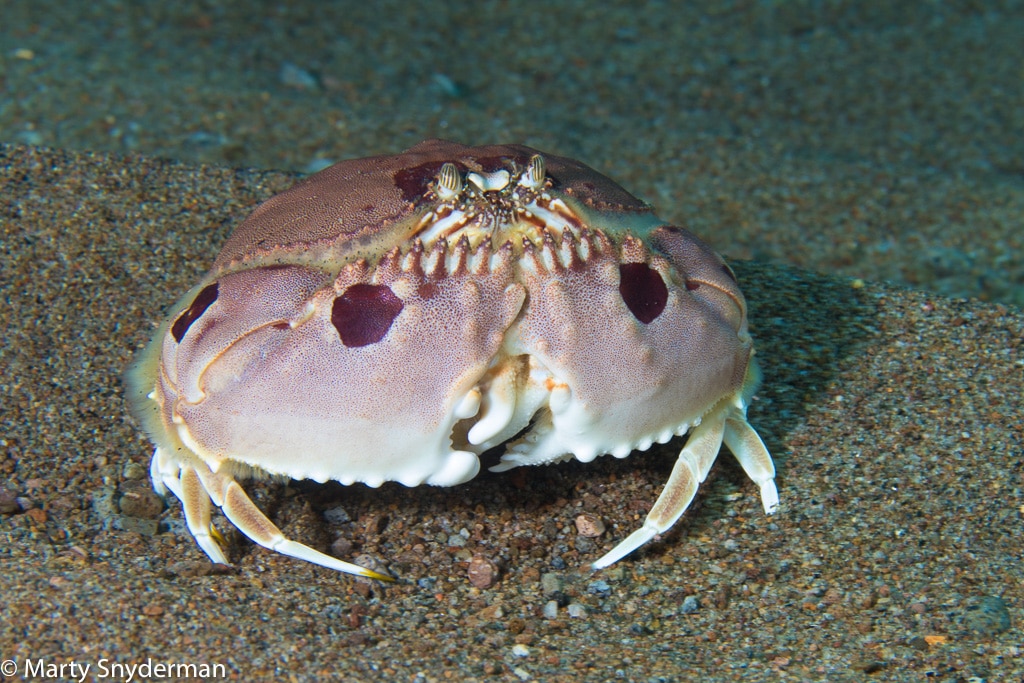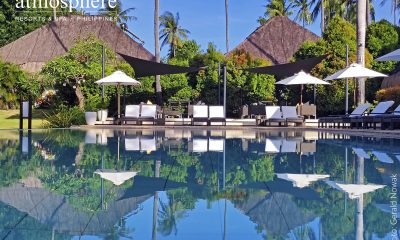Marine Life & Conservation
Critter Diving in Dumaguete
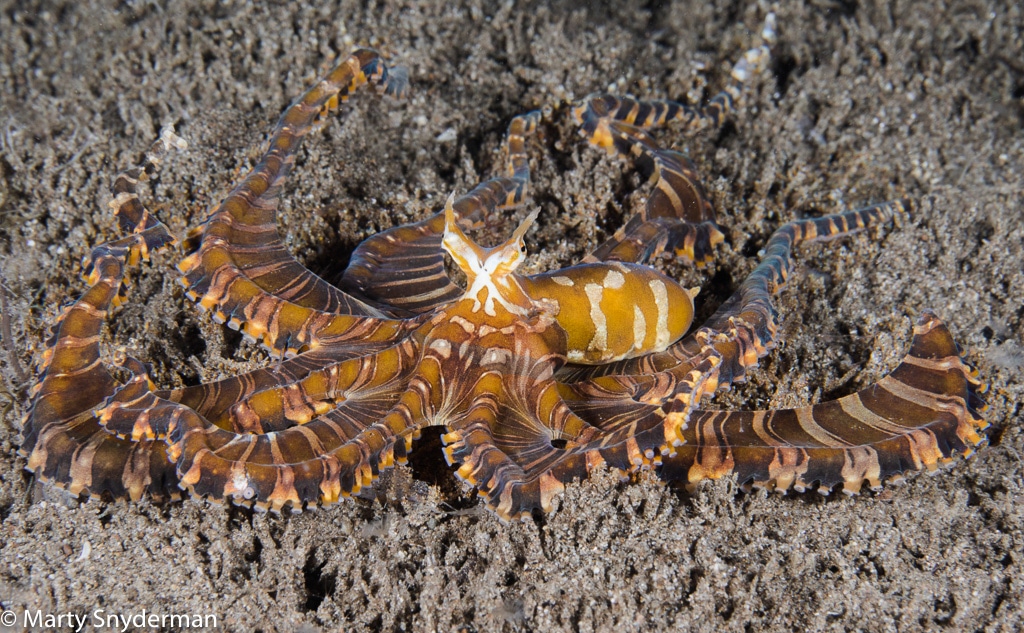
Words and Images by Marty Snyderman
While the term “muck diving” is one that would probably not pass a smell test with the marketing gurus on Madison Avenue, experienced muck divers know exploring the muck to be a featured attraction of diving in the water surrounding our resorts at both Atlantis Puerto Galera and Atlantis Dumaguete.
If you are new to diving or simply have not yet enjoyed the opportunity to muck dive, you might not be familiar with the term muck diving. Don’t let your lack of familiarity or the name turn you away. The term muck diving was first used to describe exploring areas where the bottom consists of black sand, mud and silt in sites that are often influenced by some current flow and a source of freshwater. Over the years the definition has expanded, and today the term muck diving is often used to describe dives over almost any area that has a soft bottom as well as dives around structures such as a pier or dock where the pilings along with discarded tires, bottles and other man-made objects combine to provide habitat and hiding places for all kinds of creatures.
But it is not just the nature of the sea floor or number of species that one might see that has made muck diving so popular. It is the fact that many of the encountered creatures are so bizarre, amazing, different, and well adapted for their life style and their chosen habitat that they routinely leave divers in awe of what Mother Nature has to share. Creatures such as ornate, robust, and halimeda ghostpipefishes, shrimpgobies and their partner shrimps, strange-looking scorpionfishes, sea moths, skeleton shrimp, decorator crabs, stargazers, gurnards, frogfishes, cuttlefishes, seahorses, octopuses, and snake eels are daily fare in muck sites.
In many muck diving areas, the bottom is not completely barren. Small patch reefs and anemones in the sand provide refuge for additional species of fishes, crabs, shrimps, lobsters, and squids etc. In short, muck diving can be crazy good!
The Muck Diving Experience
For many divers the first time they look around after entering the water at some highly acclaimed muck diving site, their heart sinks as the surroundings do not bring the term beauty to mind. Drab is usually more like it, and upon first consideration most muck diving sites look boring. But you’ll be selling muck diving short if you judge this book by its cover. Just trust those that brought you to the site and go see what there is to see. Odds are you’ll be absolutely amazed.
Muck Diving Technique
In many muck sites it is extremely easy to stir up the bottom and reduce the visibility with a single kick of a fin or the loss of buoyancy that causes a diver to crash into the sea floor. It is best to keep kicking and all other movements to an absolute minimum, and to achieve and maintain neutral buoyancy.
After that, it is “get low, go slow, be curious, and look closely” as you scour the bottom and any structure whether a soft coral, sponge, or debris such as a dead leaf or piece of driftwood on the sea floor. Take two looks at the slightest aberration. See something that looks just slightly different than its surroundings, and the odds are that you will be looking at some mind-blowing animal.
Be patient with yourself as you learn “how to look”. Divers that are new to muck diving almost always swim past subject after subject without spotting them during their first several muck dives. And they are almost universally amazed by the animals their dive guides spot. It is like the guides and new divers are diving in different oceans.
The key to the guides’ success is that they know where, how to look, and who they are looking for. Of course, gaining that expertise takes time. No doubt, their experience is a huge help. When you ask them how they do what they do, they are usually quick to tell you they “get low, go slow, remain curious, and look closely”. And I’ll throw in a “have fun and allow yourself to be amazed by Mother Nature”.
 Visit www.atlantishotel.com to find out more!
Visit www.atlantishotel.com to find out more!
Blogs
The Ocean Cleanup Breaks 10,000,000 KG Barrier

The Ocean Cleanup, the global non-profit project, has removed a verified all-time total of ten million kilograms (22 million lbs.) of trash from oceans and rivers around the world – approximately the same weight as the Eiffel Tower.
To complete its mission of ridding the oceans of plastic, The Ocean Cleanup uses a dual strategy: cleaning up the Great Pacific Garbage Patch (GPGP) to remove the plastic already afloat in the oceans, while stopping the flow of plastic from the world’s most polluting rivers.
Through cleaning operations in the GPGP and in rivers in eight countries, the cumulative total of trash removed has now surpassed ten million kilograms. This milestone demonstrates the acceleration of The Ocean Cleanup’s impact, while underlining the astonishing scale of the plastic pollution problem and the need for continued support and action.
While encouraging for the mission, this milestone is only a staging point: millions more tons of plastic still pollute our oceans and The Ocean Cleanup intends to continue learning, improving and innovating to solve this global catastrophe.
This announcement comes as governments from around the world meet to continue negotiations to develop a new legally binding instrument to end plastic pollution at INC4 in Ottawa, Canada. Representatives of The Ocean Cleanup will be in attendance and the organization will be urging decision-makers to collaborate towards a comprehensive and ambitious global treaty which addresses plastic at all stages of its life cycle and in all marine environments worldwide, including in areas beyond national jurisdiction.
It is encouraging to see that the need for remediation is reflected in the various options for potential treaty provisions. It is essential that the final treaty contains clear targets for the remediation of legacy plastic pollution, and reduction of riverine plastic emissions.
Tackling plastic pollution requires innovative and impactful solutions. The treaty should therefore incentivize the innovation ecosystem by fostering innovations that make maximal use of data, technology and scientific knowledge – such as those designed and deployed by The Ocean Cleanup.
‘After many tough years of trial and error, it’s amazing to see our work is starting to pay off – and I am proud of the team who has brought us to this point.’ said Boyan Slat, Founder and CEO of The Ocean Cleanup. ‘While we still have a long way to go, our recent successes fill us with renewed confidence that the oceans can be cleaned.’
The Ocean Cleanup was founded in 2013 and captured its first plastic in 2019, with the first confirmed catch in the GPGP coming soon after the deployment of Interceptor 001 in Jakarta, Indonesia. After surpassing one million kilograms of trash removed in early 2022, the non-profit project has since progressed to the third iteration of its GPGP cleaning solution, known as System 03, and a network of Interceptors currently covering rivers in eight countries, with more deployments set for 2024.
About The Ocean Cleanup
The Ocean Cleanup is an international non-profit organization that develops and scales technologies to rid the world’s oceans of plastic. They aim to achieve this goal through a dual strategy: stemming the inflow via rivers and cleaning up the legacy plastic that has already accumulated in the ocean. For the latter, The Ocean Cleanup develops large-scale systems to efficiently concentrate the plastic for periodic removal. This plastic is tracked and traced through DNV’s chain of custody model to certify claims of origin when recycling it into new products. To curb the tide via rivers, The Ocean Cleanup has developed Interceptor™ solutions to halt and extract riverine plastic before it reaches the ocean. Founded in 2013 by Boyan Slat, The Ocean Cleanup now employs a broadly multi-disciplined team of approximately 140. The foundation is headquartered in Rotterdam, the Netherlands.
For more information, visit: theoceancleanup.com and follow @theoceancleanup on social media.
Marine Life & Conservation
Steve Backshall to headline Shark Trust’s flagship event: For the Love of Sharks

Join a host of amazing, shark loving, speakers including Steve Backshall and the Shark Trust team for an evening celebrating shark conservation at the Royal Geographical Society in London this November.
Date: 29th November 2024
Time: 6-10pm
Location: Royal Geographical Society, London
Tickets: https://www.sharktrust.org/Event/flos24
The event will be a celebration of all things shark. Those lucky enough to get hold of tickets will hear from engaging guest speakers with a passion for sharks.
The line-up includes (*subject to change if unforeseen circumstances arise)
Steve Backshall: One of television’s busiest presenters, BAFTA award-winning wildlife expert Steve has been passionate about the wild world ever since he was young.
Steve’s impressive TV career has taken him all around the world, investigating a wide array of species and environments. Steve has filmed over 100 hours of children’s wildlife programmes with the BAFTA award winning Deadly 60 franchise and recently, with Sky Nature, for his new series ‘Whale with Steve Backshall’. He has been a patron for the Shark Trust for 10 years.
Simon Rogerson: is a photojournalist specialising in natural history, diving and the sea.
He is editor of SCUBA magazine, the official journal of the British Sub-Aqua Club. Simon started his career as a crime reporter but gravitated towards his ‘less depressing’ interest in underwater exploration, joining the staff of DIVE magazine in 1999. In 2005 he was named ‘Editor of the Year’ in the PPA’s Independent Publishing Awards. Simon also works as a freelance writer, contributing frequently to the Sunday Times and Telegraph, in addition to BBC Wildlife, Esquire, and a host of international diving magazines. He is the author of a book, Dive Red Sea, published by Ultimate Sports. Now based in Berkshire, Simon has been a Patron of the Shark Trust for 20 years.
More speakers to be announced soon. Head to the Shark Trust website to learn more.
The evening will also allow guests the final chance to see the Oceanic 31, shark art exhibition. Some of the artwork will be auctioned/raffled at the event, while the rest will be auctioned online to raise money for the Shark Trust Oceanic Programme.
For the Love of Sharks is an evening with something for everyone who is interested and fascinated by sharks. Join the Shark Trust, their Patrons, Trustees and Staff, along with a host of supporters for this celebration of shark conservation.
For more information or to buy a ticket: https://www.sharktrust.org/Event/flos24
-

 News3 months ago
News3 months agoCapturing Critters in Lembeh Underwater Photography Workshop 2024: Event Roundup
-

 Marine Life & Conservation Blogs3 months ago
Marine Life & Conservation Blogs3 months agoCreature Feature: Swell Sharks
-

 Blogs2 months ago
Blogs2 months agoMurex Resorts: Passport to Paradise!
-

 Gear Reviews4 weeks ago
Gear Reviews4 weeks agoGEAR REVIEW – Revolutionising Diving Comfort: The Sharkskin T2 Chillproof Suit
-

 Blogs3 months ago
Blogs3 months agoDiver Discovering Whale Skeletons Beneath Ice Judged World’s Best Underwater Photograph
-

 News3 months ago
News3 months agoPADI Teams Up with Wellness Brand Neuro to Drive Ocean Change and Create a Blue State of Mind
-

 Gear Reviews3 months ago
Gear Reviews3 months agoGear Review: Oceanic+ Dive Housing for iPhone
-

 Marine Life & Conservation2 months ago
Marine Life & Conservation2 months agoSave the Manatee Club launches brand new webcams at Silver Springs State Park, Florida


